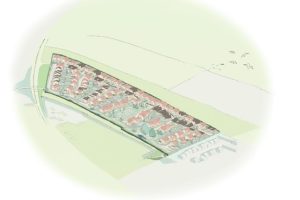Developers need to take a gamble on the PRS sector says Allsop and DWF partners

EARLIER this month, one of the first Leeds rent-to-build schemes was announced, after London developer Neighbour Ltd acquired the 56,628 sq ft Flaxby Place site in the east of the city.
But this is one of the first in Yorkshire, and whilst London, Liverpool and Manchester have schemes of their own, the UK private rented sector is nowhere near as large as that of the US, and the Northern market is behind the trend.
Paul Winstanley and Andrew Wells, both residential valuation partners at Allsop met with Richard Outhwaite, DWF real estate partner to discuss the growth of PRS and in particular build to rent and it’s future in the UK.
Mr Wells said: “It will be a challenge for developers to build for the PRS sector, and the will has to be there for investors to fund these projects. There are hurdles in the way, not just building costs, with the price of construction rising.”
It is also the cautious nature of developers, and the lack of risk-taking after being burned in the recession, said Mr Outhwaite, that is causing the UK to be slower on the uptake of PRS. He said: “At present and primarily due to current build costs developers make more profit by selling individual flats rather than selling the whole building to one investor.”
Mr Wells continued: “Councils generally have a part to play – they can identify land and opportunities which make a build to rent scheme more feasible, and if they relax obligations to do with affordable housing and more co-operation on relaxing planning obligations as well.”
Unlike in Mainland Europe, the UK has a much bigger buyers market than sellers, but the tide has been turning.
“Home ownership is a Tory pledge,” said Mr Wells. “First time buyers are being encouraged, and schemes like the Right to Buy being introduced, but people can only buy if they can afford to. There’s still a huge body of renters.
Mr Outhwaite said: “It is however recognised that we need a mixture of tenure types. It’s unrealistic in this day and age to expect everyone to buy. We live in a global world and people need and require flexibility; everyone will rent at some point in their lives.”
Paul Winstanley and Andrew Wells of Allsop
There have been embryonic steps towards a more US model of build to rent, where property and facilities management are all under the same umbrella, rather than outsourced.
North East residential firm Grainger has already completed a scheme in Barking, and Mr Wells said it was fully let in six weeks.
Mr Wells said: “The Barking scheme was very successful and it may work better there in the beginning. Local developers including Caddick, Rushbond and Bruntwood have all been enthusiastic about the growth of the build to rent sector in the region as well.”
Paul Winstanley of Allsop said: “We recognise how far we’d come, but it’s a slow process. There will definitely be more units coming through, but not a flood.
He continued: “There’s a long gestation period in these buildings. It’s a very mature market in the US, where the build-to-rent sector gets institutional-grade investment. They generally undertake sites that can have around 700 units in them. The scale of the market in the US makes it easier.
“There’s a long gestation period in these buildings. It’s a very mature market in the US, where the build-to-rent sector gets institutional-grade investment. Developers generally undertake sites that can accommodate up to several hundred units. The scale and maturity of the market in the US makes it easier.
The nature of the UK market may be evolving in a direction. The real estate partners agreed that build-to-rent is not just a city centre phenomenon, but it has a vital role in the suburbs, due to an ageing population.
Mr Winstanley continued: “Build to Rent is such a different product from what we’ve seen before in the UK. It’s very customer and hospitality-driven, with an emphasis on amenities. We can’t just take the US model as it is and bring it here, design and management is crucial in giving customers this lifestyle, but there’s no proven market for this type of rental scheme just yet – there are very few up and running test cases.”
Mr Wells said: “It’s a professional product owned by professional landlords and the quality of management is key. That means that the price you’ll have to pay is premium rent. Smaller landlords will see that if you do it well, you can earn £900 a month for a property instead of £750.”
Though London is the prime candidate for experimentation in PRS schemes, the trio of partners all agreed: “The North can deliver it, the hurdles in the UK to a growing build-to-rent market aren’t completely insurmountable.”









